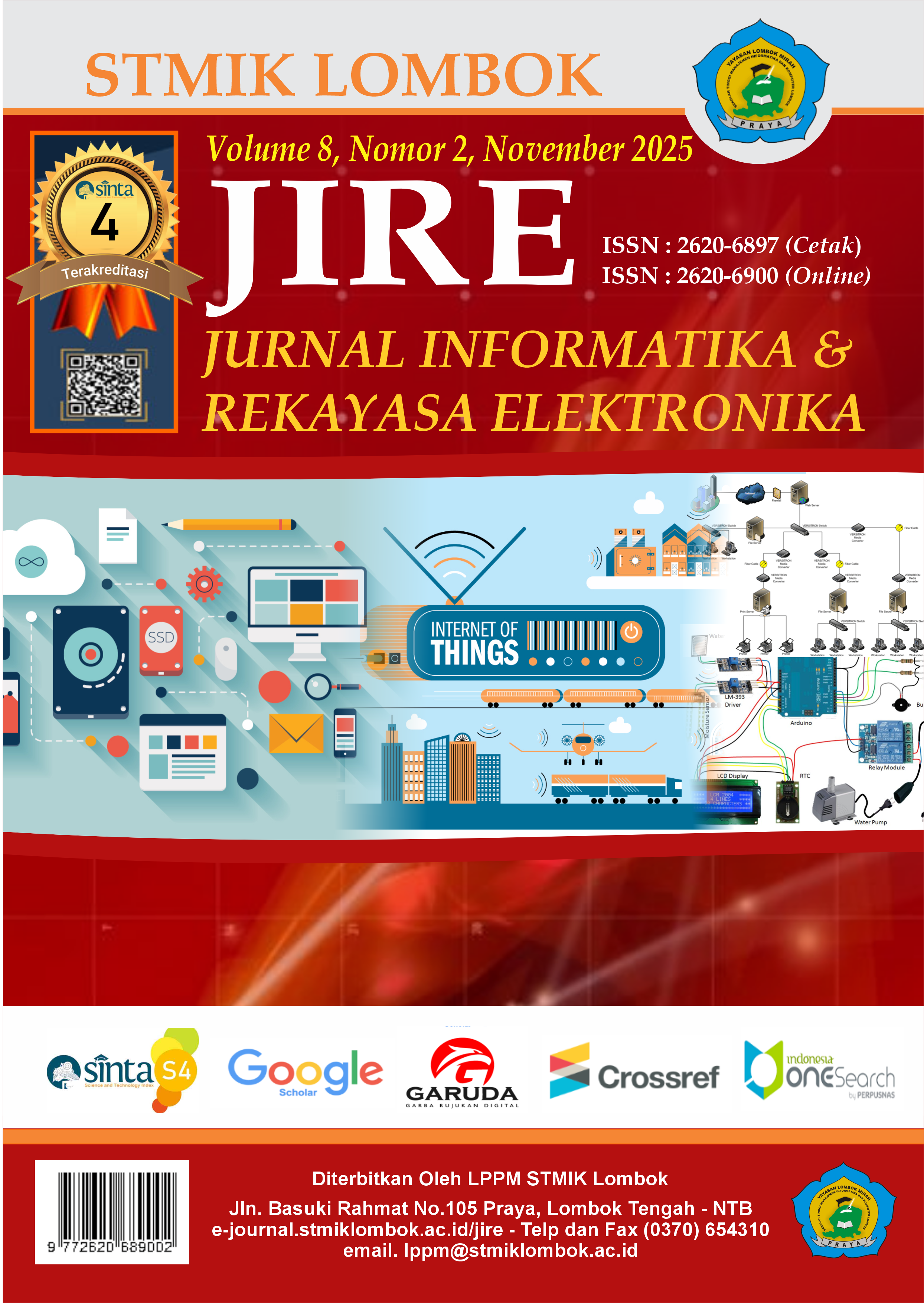PENGARUH KUALITAS LAYANAN DAN PENERIMAAN TEKNOLOGI TERHADAP KEPUASAN PENGGUNA PADA LAYANAN PEMBAYARAN ELEKTRONIK MELALUI INTEGRASI SERVICE QUALITY, TECHNOLOGY ACCEPTANCE MODEL, DAN EXPECTATION CONFIRMATION MODEL
DOI:
https://doi.org/10.36595/jire.v8i2.1829Keywords:
Digital Payment, Service Quality, Technology Acceptance Model, Expectation Confirmation Model, User satisfaction, Continuance intentionAbstract
Penelitian ini menganalisis faktor-faktor yang memengaruhi kepuasan dan niat berkelanjutan pengguna layanan pembayaran digital dengan mengintegrasikan kerangka Service Quality (SERVQUAL), Technology Acceptance Model (TAM), dan Expectation Confirmation Model (ECM). Data dikumpulkan dari 355 responden valid selama lima bulan melalui kuesioner terstruktur dan dianalisis menggunakan metode Partial Least Squares Structural Equation Modeling (PLS-SEM). Hasil penelitian menunjukkan bahwa dimensi empati berpengaruh signifikan terhadap persepsi kemudahan penggunaan, sementara reliabilitas, daya tanggap, jaminan, dan bukti fisik tidak memberikan pengaruh yang berarti. Dalam kerangka TAM, persepsi kemudahan terbukti berpengaruh kuat terhadap persepsi kegunaan, yang selanjutnya berpengaruh signifikan terhadap kepuasan pengguna. Kepuasan terbukti memiliki pengaruh langsung yang kuat terhadap niat berkelanjutan, menegaskan perannya sebagai determinan utama keterlibatan jangka panjang pengguna. Menariknya, pengalaman pembayaran digital tidak berpengaruh langsung terhadap kepuasan maupun niat berkelanjutan, serta tidak berperan sebagai moderator dalam hubungan yang diuji. Temuan ini mengindikasikan bahwa pengalaman saja tidak cukup menjamin keberlanjutan penggunaan tanpa adanya nilai tambah dan relevansi kontekstual. Secara teoretis, penelitian ini memperkaya literatur dengan menekankan peran dominan kegunaan dan kepuasan dalam membentuk niat berkelanjutan, serta menunjukkan bahwa dimensi kualitas layanan dapat berfungsi berbeda bergantung pada kematangan teknologi dan ekspektasi pengguna. Secara praktis, hasil penelitian memberikan wawasan strategis bagi penyedia layanan pembayaran digital untuk memperkuat interaksi berbasis empati, meningkatkan kegunaan aplikasi melalui integrasi fungsional dan fitur tambahan, serta memastikan kepuasan pengguna sebagai fondasi loyalitas.
Downloads
References
[1] A. Chelvarayan, S. F. Yeo, H. H. Yi, and H. Hashim, “E-wallet: a study on cashless transactions among university students,” F1000Res, vol. 11, p. 687, 2022.
[2] M. T. Amron, M. A. Mohamad, and N. H. M. Noh, “E-Wallet Payment Usage Among Young Consumers Using Technology Continuance Theory,” Information Management and Business Review, vol. 16, no. 2, pp. 189–197, 2024.
[3] M. Najib and F. Fahma, “Investigating the adoption of digital payment system through an extended technology acceptance model: An insight from the Indonesian small and medium enterprises,” Int J Adv Sci Eng Inf Technol, vol. 10, no. 4, pp. 1702–1708, 2020.
[4] T. Unarto, U. Suhud, and M. Rizan, “The Role of Continuance Intention, e-wallet Applications Users for Transaction Multi-payments in Indonesia,” Bus. Manag. Strategy, vol. 13, no. 2, p. 174, 2022.
[5] K. Imtihan and M. R. Mardi, “The Impact of Visual Quality and User Interface Responsiveness on Student Satisfaction in Academic Information Systems (AIS),” Pakistan Journal of Life and Social Sciences (PJLSS), vol. 22, no. 2, 2024, doi: 10.57239/PJLSS-2024-22.2.001455.
[6] A. Aman, K. Imtihan, and M. Rodi, “Evaluating User Satisfaction and Public Engagement in Local Government Social Media,” International Journal of Engineering, Science and Information Technology, vol. 5, no. 3, pp. 235–248, Jun. 2025, doi: 10.52088/ijesty.v5i3.905.
[7] S. Ahmad, S. H. Bhatti, and Y. Hwang, “E-service quality and actual use of e-banking: Explanation through the Technology Acceptance Model,” Information Development, vol. 36, no. 4, pp. 503–519, 2020.
[8] M. Al-Okaily, “The influence of e-satisfaction on users’e-loyalty toward e-wallet payment apps: a mediated-moderated model,” International Journal of Emerging Markets, vol. 20, no. 6, pp. 2428–2454, 2025.
[9] A. Esmaeili, I. Haghgoo, V. Davidavi?ien?, and I. Meidut?-Kavaliauskien?, “Customer loyalty in mobile banking: Evaluation of perceived risk, relative advantages, and usability factors,” Engineering Economics, vol. 32, no. 1, pp. 70–81, 2021.
[10] W. Lim, U. T. Munikrishnan, C.-M. Leong, L.-C. Hiew, M.-W. Leong, and L. Yang, “Do you want a secure e-wallet? Understanding the role of risk and security in e-wallet continuance intention,” Information & Computer Security, vol. 32, no. 3, pp. 304–321, 2024.
[11] K. Imtihan, M. Mardi, A. Tantoni, W. Bagye, and M. Zulkarnaen, “Enhancing User Satisfaction and Loyalty in MSMEs: The Role of Accounting Information Systems,” Journal of Information Systems and Informatics, vol. 7, no. 1, Mar. 2025, doi: 10.51519/journalisi.v7i1.1044.
[12] N. Nuryasin, F. M. Arizky, T. Haryanto, D. Y. Prasetyo, M. Ridwan, and M. R. Ridha, “Assessing the Performance of an E-Wallet Application Using Usability Testing Criteria,” in 2024 12th International Conference on Cyber and IT Service Management (CITSM), IEEE, 2024, pp. 1–5.
[13] J.-H. Han and H. J. Sa, “Acceptance of and satisfaction with online educational classes through the technology acceptance model (TAM): The COVID-19 situation in Korea,” Asia Pacific Education Review, vol. 23, no. 3, pp. 403–415, 2022.
[14] S. A. Kamal, M. Shafiq, and P. Kakria, “Investigating acceptance of telemedicine services through an extended technology acceptance model (TAM),” Technol Soc, vol. 60, p. 101212, 2020.
[15] Y. W. Kim, C. Lim, and Y. G. Ji, “Exploring the user acceptance of urban air mobility: extending the technology acceptance model with trust and service quality factors,” Int J Hum Comput Interact, vol. 39, no. 14, pp. 2893–2904, 2023.
[16] W. N. W. Hanafi and S. N. Toolib, “Influences of perceived usefulness, perceived ease of use, and perceived security on intention to use digital payment: a comparative study among Malaysian younger and older adults,” International Journal of Business Management (IJBM), vol. 3, no. 1, pp. 15–24, 2020.
[17] H. Purwanto, H. I. S. Adi, and H. S. Astuty, “The Influence Of Perceived Ease Of Use On The Intention To Use Digital Payment Applications In Transactions,” Jurnal Ilmiah Ekonomi Global Masa Kini, vol. 15, no. 2, pp. 111–116, 2024.
[18] I. H. Putra, E. D. Astuti, T. W. Nurdiani, and D. F. Sari, “Analysis of the Influence of Perceived Usefulness and Perceived Ease of Use on Use Intention of Digital Payment Ovo,” Jurnal Sistim Informasi dan Teknologi, pp. 87–90, 2024.
[19] D. Beura, L. Naveen, S. K. Prusty, A. P. Nanda, and C. K. Rout, “Digital payment continuance intention using Mecm: The role of perceived experience,” International Journal of Professional Business Review: Int. J. Prof. Bus. Rev., vol. 8, no. 6, p. 16, 2023.
[20] S. K. Shrestha, D. Mahat, D. Neupane, and T. B. Karki, “E-wallet usage and customer purchase intention: Understanding the mediating role of shopping satisfaction and E-wallet structure,” Multidisciplinary Reviews, vol. 8, no. 3, p. 2025091, 2025.
[21] R. B. Mostafa, “Mobile banking service quality: a new avenue for customer value co-creation,” International Journal of Bank Marketing, vol. 38, no. 5, pp. 1107–1132, 2020.
[22] J. M. Sausi, J. S. Mtebe, and J. Mbelwa, “Evaluating user satisfaction with the e-payment gateway system in Tanzania,” S Afr J Inf Manag, vol. 23, no. 1, pp. 1–9, 2021.
[23] O. Saoula et al., “Building e-trust and e-retention in online shopping: the role of website design, reliability and perceived ease of use,” Spanish Journal of Marketing-ESIC, vol. 27, no. 2, pp. 178–201, 2023.
[24] A. P. Nugroho, E. Z. Zed, and F. Syakila, “Intention to use digital bank: Role of perceived ease of use, customer knowledge, service quality, and system security,” Jurnal Ekonomi, vol. 12, no. 01, pp. 891–899, 2023.
[25] F. S. Utomo, N. Suryana, and M. S. Azmi, “Factors Influencing User Adoption of Mobile Payment System: An Integrated Model of Perceived Usefulness, Ease of Use, Financial Literacy, and Trust,” Journal of Digital Market and Digital Currency, vol. 2, no. 2, pp. 135–156, 2025.
[26] N. Wilson, K. Keni, and P. H. P. Tan, “The role of perceived usefulness and perceived ease-of-use toward satisfaction and trust which influence computer consumers’ loyalty in China,” Gadjah Mada International Journal of Business, vol. 23, no. 3, pp. 262–294, 2021.
[27] M. A. H. Pontoh, F. G. Worang, and F. J. Tumewu, “The influence of perceived ease of use, perceived risk and consumer trust towards merchant intention in using QRIS as a digital payment method,” Jurnal EMBA: Jurnal Riset Ekonomi, Manajemen, Bisnis Dan Akuntansi, vol. 10, no. 3, pp. 904–913, 2022.
[28] A. A. Nurdin, A. B. Pamungkas, and A. N. Kholifah, “Factors that influence the use of digital payments as ease of transactions in the digital era,” MATRIX: Jurnal Manajemen Teknologi Dan Informatika, vol. 13, no. 1, pp. 25–32, 2023.
[29] K. K. Coker and R. Thakur, “Alexa, may I adopt you? The role of voice assistant empathy and user-perceived risk in customer service delivery,” Journal of Services Marketing, vol. 38, no. 3, pp. 301–311, 2024.
[30] D. Saputra and B. Gürbüz, “Implementation of technology acceptance model (TAM) and importance performance analysis (IPA) in testing the ease and usability of e-wallet applications,” arXiv preprint arXiv:2103.09049, 2021.
[31] N. I. Abas and D. Puspawati, “E-wallet adoption in continuance intention as a e-payment system for live streaming shopping,” Procedia Comput Sci, vol. 234, pp. 1137–1144, 2024.
[32] M. R. Maharani and O. Usman, “The effect of perceived usefulness and perceived ease of use on the use of e-learning with TAM model in faculty of economics student of Jakarta State University,” Jurnal Pendidikan Ekonomi, Perkantoran, Dan Akuntansi, vol. 2, no. 3, pp. 55–67, 2021.
[33] A. A. Wardana, E. P. Saputro, M. Wahyuddin, and N. I. Abas, “The effect of convenience, perceived ease of use, and perceived usefulness on intention to use e-wallet,” in International Conference on Economics and Business Studies (ICOEBS 2022), Atlantis Press, 2022, pp. 386–395.
[34] O. Natalia and R. Tesniwati, “The effect of perception of trust, perception of ease of use, perception of benefits, perception of risk and perception of service quality on interest in using mobile banking bank independent in Bekasi City,” International Journal of Science, Technology & Management, vol. 2, no. 5, pp. 1722–1730, 2021.
[35] T. Islam, C. M. S. Abid, and Z. Ahmer, “How perceptions about ease of use and risk explain intention to use mobile payment service in Pakistan? The mediating role of perceived trust,” Pakistan Journal of Commerce and Social Sciences (PJCSS), vol. 14, no. 1, pp. 34–48, 2020.
[36] N. F. Mohd Sah, W. E. W. Rashid, N. S. Mat Shah, and F. S. Azmi, “Touch’N Go E-Wallet: A User Experience Questionnaire (UEQ) Analysis for Improvement,” European Proceedings of Social and Behavioural Sciences, 2024.
[37] D. A. Paramita and A. Hidayat, “The effect of perceived ease of use, perceived usefulness, and perceived benefits on interest in using Bank Syariah Indonesia mobile banking,” International Journal of Research in Business and Social Science, vol. 12, no. 5, pp. 1–9, 2023.
[38] V. Winata and O. Arma, “ANALYZING THE EFFECT OF E-WALLET USABILITY ON CUSTOMER RETENTION IN MOBILE PAYMENT APPS,” JUMDER: Jurnal Bisnis Digital dan Ekonomi Kreatif, vol. 1, no. 2, pp. 38–57, 2025.
[39] F. Davis and F. Davis, “Perceived Usefulness, Perceived Ease of Use, and User Acceptance of Information Technology,” MIS Quarterly, vol. 13, p. 319, Sep. 1989, doi: 10.2307/249008.
[40] J. F. Hair, J. J. Risher, M. Sarstedt, and C. M. Ringle, “When to use and how to report the results of PLS-SEM,” Jan. 14, 2019, Emerald Group Publishing Ltd. doi: 10.1108/EBR-11-2018-0203.
[41] Y. Wang, S. Wang, J. Wang, J. Wei, and C. Wang, “An empirical study of consumers’ intention to use ride-sharing services: using an extended technology acceptance model,” Transportation (Amst), vol. 47, no. 1, pp. 397–415, 2020.
[42] J. Henseler, C. M. Ringle, and M. Sarstedt, “A new criterion for assessing discriminant validity in variance-based structural equation modeling,” J Acad Mark Sci, vol. 43, no. 1, pp. 115–135, Jan. 2015, doi: 10.1007/s11747-014-0403-8.
Downloads
Published
How to Cite
Issue
Section
License
Semua tulisan pada jurnal ini menjadi tanggungjawab penuh penulis.













